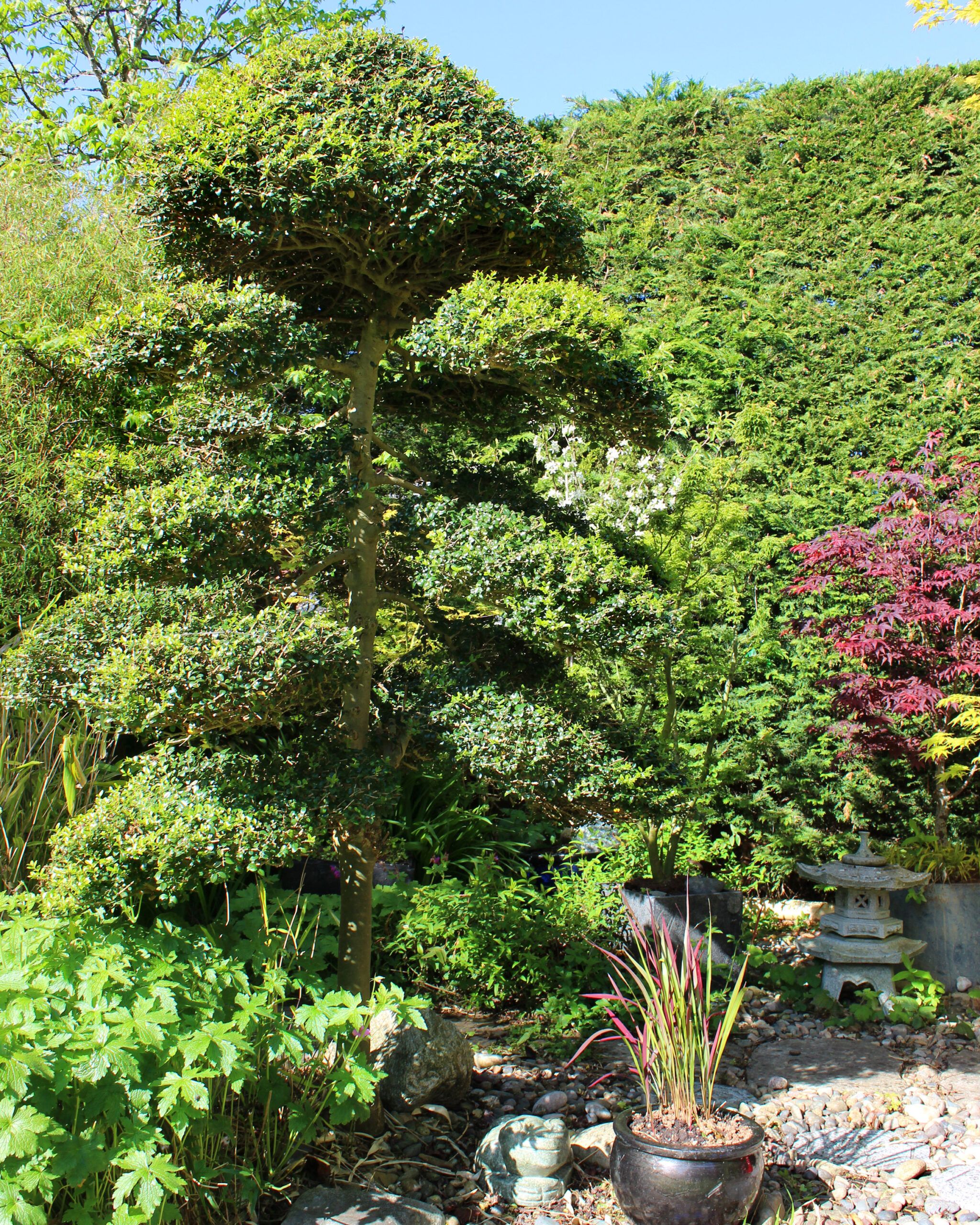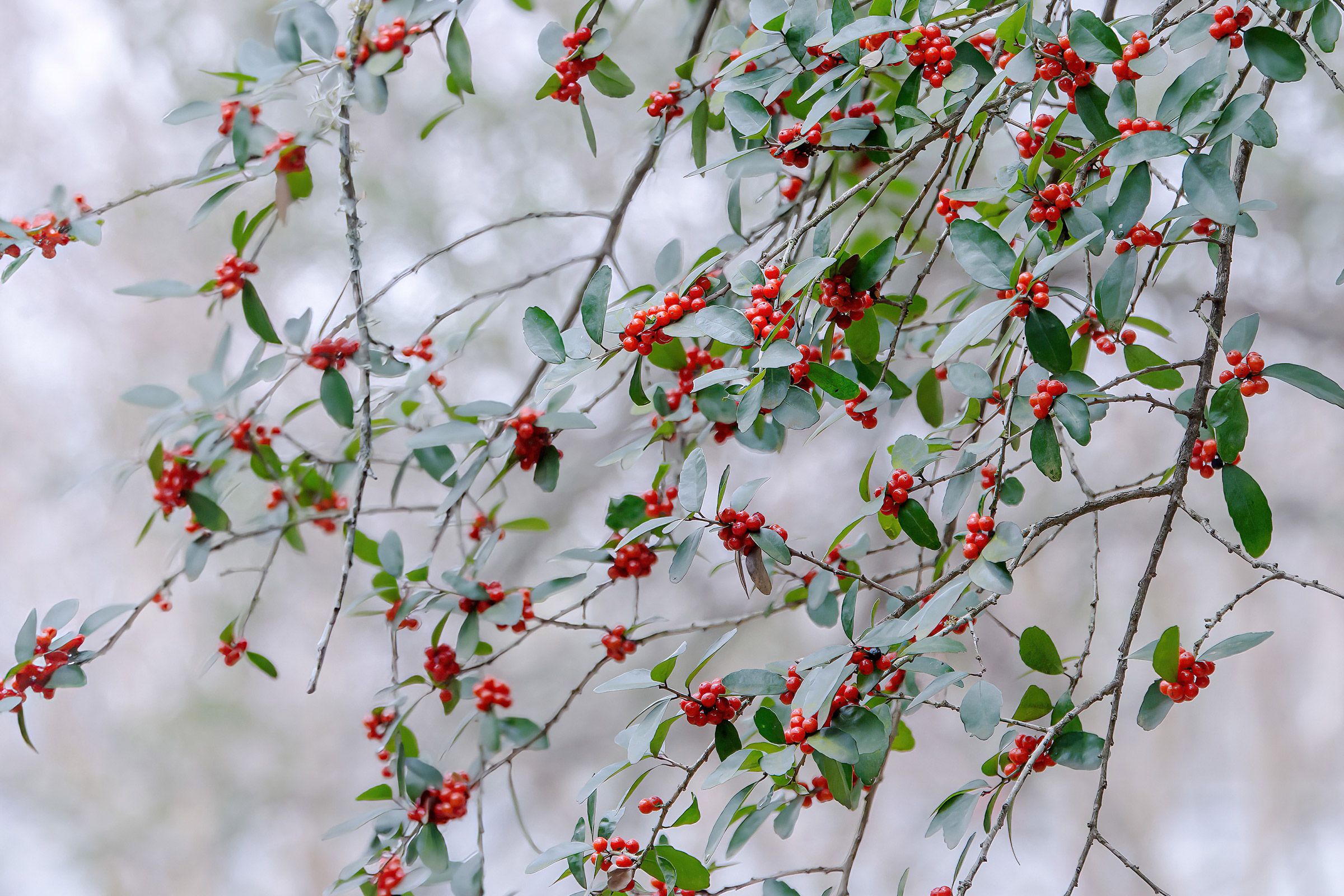Holly bushes are synonymous with the winter and holiday season, but these versatile evergreens are just as great year-round. Known for their dense, glossy foliage and colorful berries, they can add color and structure to any landscape. They thrive in full sun to partial shade and come in a variety of sizes to fit any lawn.
In the video above, This Old House landscaping expert Jenn Nawada discusses different holly species and shares valuable insights on incorporating these charming shrubs into your outdoor spaces.
Popular Types of Holly Bushes
Holly bushes belong to the genus Ilex, which includes over 480 species ranging from small shrubs to tall trees. Blue, Japanese, and Possumhaw are the most popular. Each type has unique characteristics and benefits for different garden settings.
Blue Holly (Ilex meserveae)

Blue Holly, also known as Ilex meserveae, is a hardy variety closely resembling the classic European holly associated with Christmas. This species is prized for its bright red berries that appear in fall and its bluish-green leaves, which have a glossy, leathery texture. It’s tolerant to cold and grows quickly, reaching 6-8 feet tall at maturity.
In the spring, Blue Holly produces small white flowers. Its stems have a distinctive purplish color, contributing to its visual appeal even when its berries aren’t visible.
Japanese Holly (Ilex crenata)

Native to Asia, Japanese Holly (Ilex crenata) is a great choice for gardeners looking to create formal hedges or topiaries. It can maintain a shape with regular pruning, making it a good option for structured landscape designs. The dark, lush foliage provides a classic and refined look that complements modern and traditional yard designs. It’s known for the following characteristics:
- Dense, compact growth habit
- Purple or blackberries that are often hidden beneath the foliage
- Resemblance to boxwood shrubs
- Small, spineless leaves with a deep green color
Possumhaw Holly (Ilex decidua)

Possumhaw Holly, also known as Ilex decidua, is a deciduous variety that drops its leaves in the fall, revealing an abundance of bright red berries. It works well in naturalized settings and tolerates various soil conditions, including wet areas.
Planting and Growing Holly Bushes
Like any plant, holly bushes need proper care to thrive. Here are some guidelines to follow.
When To Plant Holly Bushes
Plant holly bushes at least 6–8 weeks before extreme temperatures are expected, ideally in the spring. This timing allows the plants to establish root systems before facing the stress of summer heat or winter cold. However, fall planting can also be successful in regions with mild climates. Cooler temperatures during fall reduce transplant shock, and the soil is often workable and moist.
Growing Conditions
Holly bushes are adaptable plants, but they thrive under these specific conditions:
- Soil: They prefer moist, well-drained soil with a slightly acidic pH.
- Sunlight: Blue Holly and Japanese Holly can tolerate full sun to partial shade.
- Temperature: Blue Holly is hardy in USDA zones 5–8, while Japanese and Possumhaw Holly perform well in zones 5–9.
- Water: Regular watering supports growth, especially during the establishment period.
Planting Process
When planting holly bushes, follow these steps:
- Choose a location that meets the plant’s sunlight and soil requirements.
- Dig a hole twice as wide as the root ball and just as deep.
- Remove the plant from the container and loosen its roots.
- Place the plant in the hole, checking that it’s at the same depth as it was in the container.
- Backfill with soil, firming gently to eliminate air pockets.
- Water thoroughly and add a layer of mulch around the base of the plant.
Caring for Holly Bushes
Once your holly bushes are planted, here are some care tips to make sure they stay healthy throughout the year:
- Fertilizing: Apply a balanced, slow-release fertilizer in early spring before new growth begins. Choose a fertilizer formulated for acid-loving plants, as hollies prefer slightly acidic soil. Avoid over-fertilizing, which can lead to excessive growth and reduced berry production.
- Pruning: Prune holly bushes in late winter or early spring before new growth starts. Remove dead, damaged, or crossing branches to maintain the plant’s shape and promote healthy growth. Japanese Holly may require more frequent trimming to maintain its shape.
- Watering: Holly bushes prefer consistently moist soil but cannot tolerate waterlogged conditions. Water deeply and regularly, especially during dry spells and the first growing season after planting. Established plants are more drought-tolerant but still benefit from regular watering. Mulching around the base can help retain moisture and reduce weed competition.
- Winter protection: While many holly species are cold-hardy, some varieties may need winter protection in harsh climates. For Japanese Holly in zones with severe winters, wrap the plants in burlap to protect them from winter burn and desiccating winds.
Landscaping with Holly Bushes
Holly bushes’ evergreen foliage and colorful berries make them work in various garden styles. Here are a few ideas for how to use them:
- Accent plants: Holly bushes’ distinctive appearance can draw attention to specific areas or serve as eye-catching focal points in mixed borders. You can also plant holly in containers for use on patios and decks.
- Foundation planting: Use holly bushes as foundation plants to create a year-round green backdrop for your home. Their dense growth habit helps soften architectural lines and provides a lush, welcoming appearance. Foundation plantings can also insulate your home by blocking cold winds and providing a buffer against temperature extremes.
- Privacy screens: Taller holly varieties, such as Blue Holly, can be planted in rows to create natural privacy screens or windbreaks. Their evergreen foliage provides year-round coverage and visual interest.
- Winter interest: Holly bushes truly shine in winter landscapes. Their evergreen foliage and bright berries provide color and texture when many other plants are dormant. Consider planting hollies near windows or entryways to enjoy their winter beauty from indoors. The striking contrast between the berries and the snow-covered landscape creates a picturesque winter scene.
